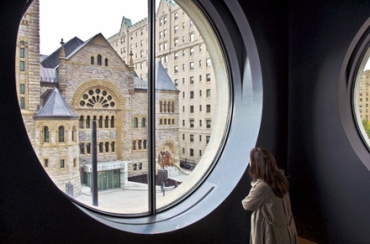
Boat activity is bustling on the shores of Santa Cruz, the most populous of the Galapagos Islands. (Julia Pelish photo)
PUERTO AYORA, SANTA CRUZ, GALAPAGOS ISLANDS, ECUADOR — Yvonne Mórtola walks down Avendida Charles Darwin with a frown. One white Toyota pick-up truck after another passes down this two-lane asphalt road in the most populous city of the Galapagos Islands. Engine revs and muffler coughs have suffocated the sounds of nature that so signify these protected islands off the Ecuadorean coast. No longer is it easy for Santa Cruz residents like Mórtola to stand on a street corner of Avendida Charles Darwin and hear waves lapping, finches’ chirps or sea lion barks.
“This used to be a dirt road,” says Mórtola, a top-level Ecuador National Parks Service naturalist who works as a guide for tour operator Ecoventura. “I used to be able to throw a Frisbee to my dog down here, but I can’t do that anymore. It just isn’t safe on the road.”
While 97 percent of the islands are protected by the parks, it’s what’s happened to the other 3 percent that worries Mórtola and others concerned about the environment on the Galapagos. In the 1990s, migrants arrived looking to get in on one of the world’s oddest commodity booms. Call it the Great Sea Cucumber Rush. The marine animal that helps clean oceans of bacteria, algae and waste is highly coveted by the Chinese and Japanese as a delicacy and an aphrodisiac. With an abundance of sea cucumbers, the Galapagos became a focal point for the trade. Fishermen could get $1 per sea cucumber and reports said that 10,000 sea cucumbers would be shipped daily from the Galapagos. Those fishermen could sometimes catch in an hour enough sea cucumbers with an equivalent value of a week’s worth of traditional fishing.
Mórtola, who has lived on the islands for more than a quarter-century, says she remembers prostitutes on Santa Cruz earning so much money during the height of the boom that “they would light their cigarettes with $10 bills.”
The population of Santa Cruz rose nearly four-fold, reaching 10,000 before the government passed a unique policy called the Galapagos Resident Law, which states that no one can live on the islands unless they were born there, married someone who resides there or could prove they worked there prior to 1998, the year the law was enacted. Still, the population of Santa Cruz has continued to grow, reaching 16,500 as of the last census and Puerto Ayora is at 12,000 people. In recent years, the government has been expelling thousands of illegal, undocumented migrants from the island.
“You look at Santa Cruz, and it used to be a very nice community,” says Pablo Jaramillo, the captain of Eric, Ecoventura’s recently renovated yacht, and a resident of San Cristobal, the second most populous island (8,000). “But there are too many people now. You do not even know your neighbour in some cases.”
READ ‘GALAPAGOS TRAVEL TIPS: WHAT TO EXPECT WHEN YOU GO’
More lush than the other 12 main islands in the chain, Santa Cruz is home to the Darwin Research Station, where the giant tortoise population is being rehabilitated in a huge undertaking that involves such careful incubation of eggs that researchers can create the sex they want by manipulating the temperature. When the incubator is set to 29.5 Celsius degrees, females will be born. At 28 Celsius, a male will hatch. With the species needing to grow, more females are being created at the station.
read more »







